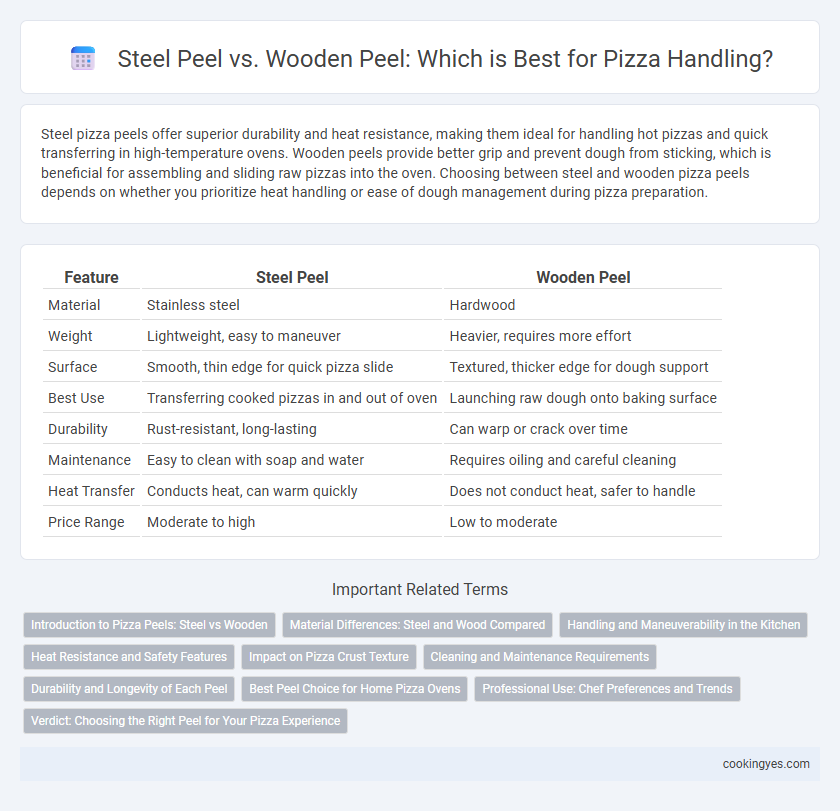Steel pizza peels offer superior durability and heat resistance, making them ideal for handling hot pizzas and quick transferring in high-temperature ovens. Wooden peels provide better grip and prevent dough from sticking, which is beneficial for assembling and sliding raw pizzas into the oven. Choosing between steel and wooden pizza peels depends on whether you prioritize heat handling or ease of dough management during pizza preparation.
Table of Comparison
| Feature | Steel Peel | Wooden Peel |
|---|---|---|
| Material | Stainless steel | Hardwood |
| Weight | Lightweight, easy to maneuver | Heavier, requires more effort |
| Surface | Smooth, thin edge for quick pizza slide | Textured, thicker edge for dough support |
| Best Use | Transferring cooked pizzas in and out of oven | Launching raw dough onto baking surface |
| Durability | Rust-resistant, long-lasting | Can warp or crack over time |
| Maintenance | Easy to clean with soap and water | Requires oiling and careful cleaning |
| Heat Transfer | Conducts heat, can warm quickly | Does not conduct heat, safer to handle |
| Price Range | Moderate to high | Low to moderate |
Introduction to Pizza Peels: Steel vs Wooden
Pizza peels are essential tools used to transfer pizzas in and out of ovens with precision and safety. Steel peels offer superior durability and a thinner edge for easily sliding under pizzas, especially in high-temperature brick ovens. Wooden peels provide better grip and prevent sticking due to their rougher surface, making them ideal for assembling and launching pizzas.
Material Differences: Steel and Wood Compared
Steel pizza peels deliver superior heat resistance and durability, enabling effortless handling of hot pizzas without warping or cracking. Wooden pizza peels offer a natural, non-stick surface that prevents dough from sticking during preparation but require more maintenance to avoid splintering and warping. The choice between steel and wood depends on balancing durability and dough-handling properties, with steel excelling in heat tolerance and wood favored for its gentle surface on raw dough.
Handling and Maneuverability in the Kitchen
Steel peels offer superior maneuverability in the kitchen due to their thinner, lightweight design, allowing for precise pizza handling and easy sliding under dough. Wooden peels provide better grip for transferring uncooked pizzas, preventing sticking but can be bulkier and less agile during quick movements. Choosing between steel and wooden peels depends on balancing the need for control during transfer and efficient maneuvering in a busy kitchen environment.
Heat Resistance and Safety Features
Steel pizza peels offer superior heat resistance, allowing them to withstand higher temperatures without warping, making them ideal for frequent use in professional kitchens. Wooden peels provide natural insulation, reducing the risk of burns when handling hot pizzas, and their non-slip surface enhances safety during transfer. Both materials ensure pizza safety, but steel excels in durability while wood offers better thermal protection for the user.
Impact on Pizza Crust Texture
Steel peels provide a rigid, smooth surface that allows for quick and easy pizza transfer, promoting a crispier crust by reducing moisture retention during handling. In contrast, wooden peels tend to absorb moisture, which can soften the dough and result in a chewier crust texture. Choosing between steel and wooden peels directly impacts the final crust quality, with steel favoring crunchiness and wood enhancing softness.
Cleaning and Maintenance Requirements
Steel peels require minimal cleaning since their smooth, non-porous surface resists dough and food residue buildup, making maintenance quick and hygienic. Wooden peels absorb moisture and oils, necessitating thorough drying and occasional oiling to prevent warping and bacterial growth. Proper care for each peel type significantly extends its lifespan while ensuring safe and efficient pizza handling.
Durability and Longevity of Each Peel
Steel peels offer superior durability due to their resistance to warping, cracking, and moisture damage compared to wooden peels, making them ideal for long-term use in high-heat environments. Wooden peels, while less durable, provide a natural, non-stick surface that is gentler on dough but can deteriorate over time with exposure to moisture and high temperatures. Investing in a steel peel ensures enhanced longevity and consistent performance, especially for frequent pizza handling and baking.
Best Peel Choice for Home Pizza Ovens
Steel peels offer superior durability and a thinner edge, making them ideal for quickly sliding pizzas on and off hot home pizza oven stones without sticking. Wooden peels provide better resistance to dough sticking due to their porous surface and are safer to load and retrieve pizzas from extremely hot ovens. For home pizza ovens, choosing between steel and wooden peels depends on handling preference and frequency of use--steel excels in precision and longevity, while wood offers ease of use and prevents dough adhesion.
Professional Use: Chef Preferences and Trends
Professional chefs often prefer steel peels for their durability, lightweight nature, and ability to slide pizzas quickly in and out of high-temperature ovens, ensuring crisp crusts and consistent cooking. Wooden peels remain favored for assembling and transferring uncooked pizzas due to their nonslip surface and ability to absorb moisture, preventing dough from sticking during preparation. Current trends reveal a growing hybrid approach, with kitchens employing steel peels for baking and wooden peels for dough handling to maximize efficiency and product quality.
Verdict: Choosing the Right Peel for Your Pizza Experience
Steel peels excel in durability and ease of sliding pizzas into hot ovens, making them ideal for frequent use and professional settings. Wooden peels provide superior non-stick properties when launching dough and offer a traditional aesthetic preferred by artisanal pizza makers. Selecting the right peel depends on your baking style and frequency, with steel peels favored for efficiency and wooden peels chosen for their classic handling benefits.
Steel Peel vs Wooden Peel for Pizza Handling Infographic

 cookingyes.com
cookingyes.com